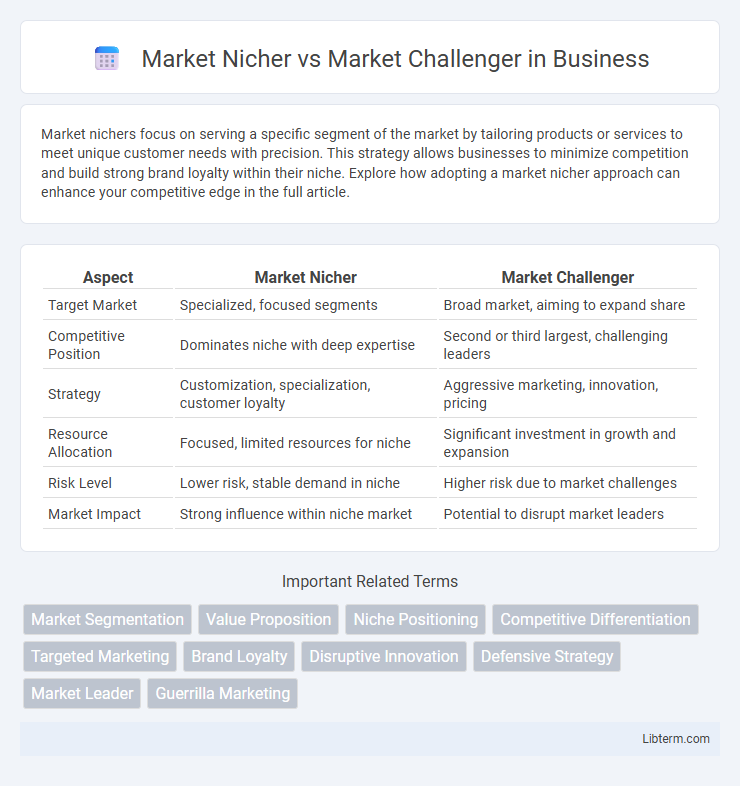Market nichers focus on serving a specific segment of the market by tailoring products or services to meet unique customer needs with precision. This strategy allows businesses to minimize competition and build strong brand loyalty within their niche. Explore how adopting a market nicher approach can enhance your competitive edge in the full article.
Table of Comparison
| Aspect | Market Nicher | Market Challenger |
|---|---|---|
| Target Market | Specialized, focused segments | Broad market, aiming to expand share |
| Competitive Position | Dominates niche with deep expertise | Second or third largest, challenging leaders |
| Strategy | Customization, specialization, customer loyalty | Aggressive marketing, innovation, pricing |
| Resource Allocation | Focused, limited resources for niche | Significant investment in growth and expansion |
| Risk Level | Lower risk, stable demand in niche | Higher risk due to market challenges |
| Market Impact | Strong influence within niche market | Potential to disrupt market leaders |
Introduction to Market Nichers and Market Challengers
Market nichers specialize in serving a specific segment or niche within a broader market, targeting unique customer needs with tailored products or services that larger competitors often overlook. Market challengers aggressively pursue increased market share by directly competing with the market leader through strategies such as innovation, pricing, and marketing campaigns. Both approaches play crucial roles in competitive dynamics, where nichers excel in specialization and challengers focus on expansion and disruption.
Defining Market Nichers: Strategies and Characteristics
Market nichers concentrate on specialized segments, targeting specific customer needs that larger competitors often overlook. Their strategies emphasize deep customer understanding, customized products, and personalized service to build strong loyalty and reduce direct competition. By focusing on differentiation and agility, market nichers create sustainable advantages in narrow market areas where scale is less critical.
Understanding Market Challengers: Key Features and Tactics
Market challengers aggressively target the market leader's position by leveraging competitive pricing, innovative product features, and intensified promotional efforts to capture market share. They often employ tactics such as product differentiation, strategic alliances, and rapid market entry to disrupt established players. Understanding these key features enables businesses to anticipate challengers' moves and develop counter-strategies to maintain competitive advantage.
Target Market Focus: Nicher Versus Challenger Approaches
Market nichers concentrate on specialized market segments with highly targeted products or services tailored to specific customer needs, ensuring deep customer loyalty and reduced competition. Market challengers pursue broader market segments by aggressively competing with market leaders through pricing, promotion, and product innovation to capture larger market shares. Nichers prioritize depth and specialization, while challengers focus on scale and competitive positioning within more extensive markets.
Product Differentiation Strategies in Niching and Challenging
Market nichers build competitive advantage through highly specialized product differentiation, targeting narrow customer segments with tailored features and unique value propositions. Market challengers employ broad product differentiation strategies, enhancing product quality, innovation, and branding to directly compete with market leaders and capture larger customer bases. Nichers emphasize depth and distinctiveness in product offerings, whereas challengers prioritize scale and versatility to disrupt market dominance.
Competitive Advantage: Nicher vs. Challenger Perspectives
Market nichers leverage specialized expertise and focus on narrow customer segments to create strong competitive advantages through customer loyalty and tailored products. Market challengers compete by aggressively targeting dominant market players, utilizing resources like scale economies, advanced technology, and extensive marketing to gain market share. While nichers excel in agility and customer intimacy, challengers benefit from broader reach and the ability to disrupt incumbents through innovation and pricing strategies.
Risk Factors and Challenges Faced by Nichers and Challengers
Market nichers face risks such as limited market size and vulnerability to changes in consumer preferences, which can restrict growth and profitability. Market challengers encounter challenges from established leaders, requiring significant investment in marketing and innovation to gain market share while risking retaliation through price wars or increased competition. Both face pressure to continuously adapt strategies to maintain competitive advantage and manage the uncertainty of market dynamics.
Case Studies: Successful Market Nichers and Challengers
Successful market nichers like Tesla initially focused on a specific segment--luxury electric vehicles--achieving a strong market position before expanding, demonstrating the power of specialization. Market challengers such as Samsung employed aggressive strategies, including significant R&D investment and competitive pricing, to overtake leaders in the smartphone industry. Case studies of both reveal that nichers benefit from deep customer insight and tailored offerings, while challengers excel through scale, innovation, and market disruption tactics.
Choosing the Right Strategy: Factors Influencing Business Positioning
Market nichers focus on specialized segments with unique customer needs, leveraging deep expertise and tailored offerings to maintain strong loyalty and high profit margins. Market challengers target dominant competitors by investing in aggressive marketing, innovation, and pricing strategies to gain market share rapidly. Choosing the right strategy depends on factors such as company resources, competitive intensity, customer preferences, and long-term growth objectives, ensuring alignment with overall business capabilities and market dynamics.
Future Trends for Market Nichers and Market Challengers
Market nichers are poised to benefit from increasing demand for specialized products and personalized services within niche markets, leveraging advanced analytics and AI to anticipate unique customer needs. Market challengers will focus on scaling innovation and aggressive market penetration through digital transformation and sustainability initiatives to outpace competitors. Future trends indicate that adaptability and technology integration will be critical for both nichers and challengers to maintain competitive advantage.
Market Nicher Infographic

 libterm.com
libterm.com